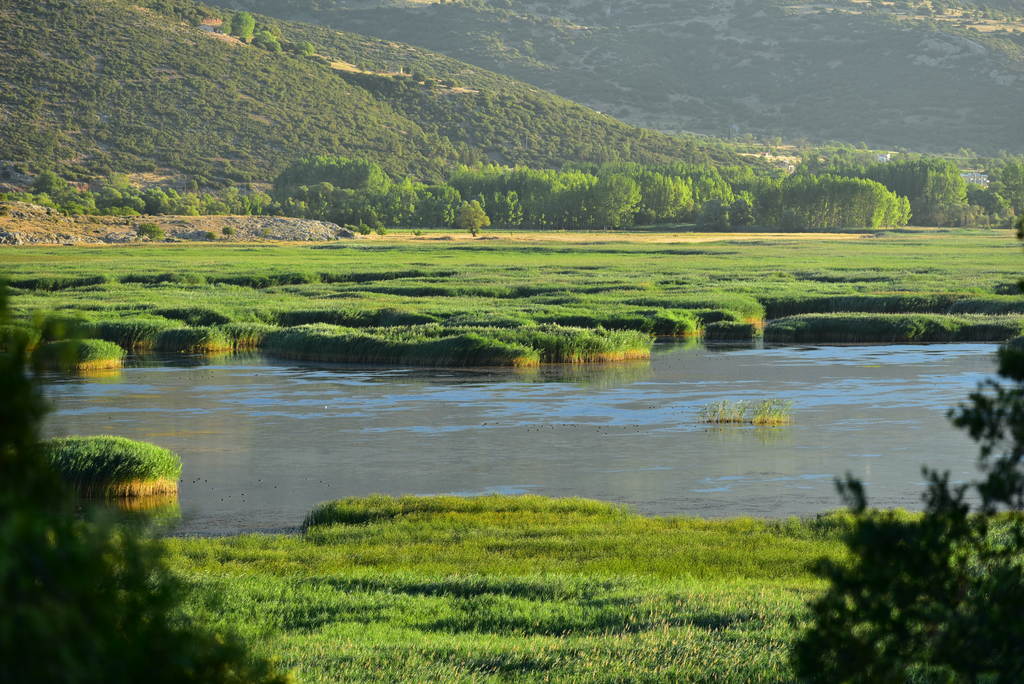December 2018 - LIFE Stymfalia
Α) Identity of the project
| Title/ N° |
Sustainable Management and Financing of Wetland Biodiversity - The case of Lake Stymphalia LIFE12 NAT/GR/000275 |
| Duration |
60 months |
| Budget |
€ 2,013,290 |
|
Beneficiaries |
Coordinating Beneficiary: Piraeus Bank Associated Beneficiaries: Piraeus Bank Group Cultural Foundation Municipality of Sikyonion OIKOM Environmental Studies Ltd Society for the Protection of Prespa Centre for Renewable Energy Sources and Saving (CRES) |
| Location of activities |
Greece, Stymphalia, Region of Corinthia |
| Website | http://www.lifestymfalia.gr/en.aspx |
| Contact |
Christina Pelekanaki and Katerina Skouloudaki, Piraeus Bank This email address is being protected from spambots. You need JavaScript enabled to view it. |
Description/Aim
The aim of LIFE-Stymfalia project is the restoration of the wetland and the long-term protection and management of Lake Stymphalia, connecting biodiversity with business.
The project's specific objectives:
-
The conservation and enhancement of the status of target species and of their natural habitats. Target species include three bird species (Ferruginous Duck, Purple heron, and Little Bittern), two bat species (Lesser and Greater Horseshoe Bat), as well as an endemic fish species (Stymphalia Minnow or Daska).
-
The double identity of the area: As a protected wetland and a cultural landscape.
-
The engagement of the local community, especially farmers, in the sustainable management of the lake.
-
The creation of jobs deriving from the innovative initiatives of the project and sustainable entrepreneurship.
Β) Best Practices
-
Operation of a Local Management Unit (LMU) - Informing/Engaging the local community
The Local Unit, consisting of three locals and located at the Environment Museum of Stymphalia, monitored and patrolled the area during the entire course of the project, coordinated the reed bed cuttings, and updated the local community on the progress of the project. This way, we have ensured the awareness / activation of the local community on a daily, immediate and familiar level.
-
Creation of the Farmers’ Network of Stymphalia and promotion of sustainable farming entrepreneurship and innovation – Raising awareness/ changing mentality of residents towards environmentally friendly practices
The Network includes more than 160 members, all of whom are local farmers. In this framework, nine training seminars took place - workshops and field trips for local farmers, aiming to inform them about the benefits of organic farming and integrated farming management. Especially for the Farmers’ Network of Stymphalia the logo “Stymphalia my Home” was designed. Twenty-six (26) member-beneficiaries of the Network already use the logo on their packaging, adding value to their local products.
-
Participation in international platforms and initiatives - Disseminating the results globally
-
In the IUCN “Incubator for Nature Conservation” initiative, aiming to promote business opportunities in order to enhance financing for protected areas and
-
In the EU Business and Biodiversity platform (EU B@B Platform) which provides an EU level forum for sustained and strategic dialogue about the links between business and biodiversity. The Platform aims to develop tools and approaches that integrate biodiversity considerations into business practice.
-
Environmental and cultural interpretation trail: “Man and Nature on the Paths of the Time” - Project area’s promotion
The trail leads visitors from the Environment Museum to Ancient Stymphalos and the lake. On an elevated site there is a bird observatory built specially to serve the visitors. The path was among the European Natura 2000 Awards finalists for 2018 and also among the top five initiatives in the category “Communication”.
C) Results
The results of the project can be used by the local entrepreneurs, local authorities, competent management body and policy makers. More specifically:
Business Plan. For the first time, the comparative advantages of the protected area were recorded and business opportunities were assessed, taking into consideration the environment and the lake's unique biodiversity.
Study for the economic evaluation of ecosystem services. For the first time the ecosystem services of the area are being depicted and considered as rare and their devaluation or degradation entails a considerable cost. The total value of Ecosystem services in Lake Stymphalia amounts annually more than € 6,500,000, based on current estimates.
Studies for the utilisation of biomass from reed cuttings and farming residues in the area. The reeds from the summer reed bed cutting were collected, chopped, and transported to a composting plant, where they were mixed with other materials. Compost was made for the first time using the reeds of the lake as the main raw material. The reeds from the winter reed bed cutting were transported to a local pellet production unit. Following comminution, they were submitted to testing. The first pellets produced from reeds and wood were submitted to endurance testing by CRES, with promising results for commercial use.
Digital application for the monitoring of the protected area. The application will process satellite images and map cartographic changes in the landscape of Lake Stymphalia, presenting the evolution of the lake’s natural environment, the pressures to the natural environment of the area and the changes over time.
3 Technical Guides for the Reed Bed Management of Lake Stymphalia, the Monitoring of Bird Species and Habitats, as well as the Sustainable Financing of protected sites.





